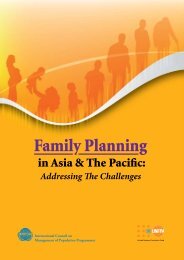SRH and HIV/AIDS Linkages at Policies, Programmes and Service ...
SRH and HIV/AIDS Linkages at Policies, Programmes and Service ...
SRH and HIV/AIDS Linkages at Policies, Programmes and Service ...
You also want an ePaper? Increase the reach of your titles
YUMPU automatically turns print PDFs into web optimized ePapers that Google loves.
e accomplished if there is support<strong>and</strong> commitment by the government<strong>at</strong> the policy level, development ofappropri<strong>at</strong>e institutional mechanisms,coordin<strong>at</strong>ion <strong>and</strong> collabor<strong>at</strong>ion, r<strong>at</strong>herthan simply exp<strong>and</strong>ing <strong>and</strong> linkingthe vertical. Linked response shouldbe institutionalised in all policiesrel<strong>at</strong>ed to RH, <strong>HIV</strong>/<strong>AIDS</strong> <strong>and</strong> interministerialcoordin<strong>at</strong>ion is requiredamong different ministries includinghealth, educ<strong>at</strong>ion <strong>and</strong> home affairs.Prevention should be a key elementin the n<strong>at</strong>ional response to <strong>HIV</strong>.One of the four key priorities of theUNICEF <strong>and</strong> UN<strong>AIDS</strong> global Unitefor Children, Unite against <strong>AIDS</strong>campaign is - ‘preventing infectionamong adolescents <strong>and</strong> young people’ -is especially pertinent in Bangladesh.The cornerstone of <strong>HIV</strong> prevention issafer sex. Young people need practicalhelp in the form of appropri<strong>at</strong>e lifeskills <strong>and</strong> youth-friendly health serviceswhere they can seek advice, have theirqueries answered <strong>and</strong> obtain condoms<strong>and</strong> tre<strong>at</strong>ment for STIs. Young peopleneed <strong>and</strong> have the right to accesscomprehensive inform<strong>at</strong>ion aboutSTIs, <strong>HIV</strong> <strong>and</strong> <strong>AIDS</strong> prevention <strong>and</strong>positive living, <strong>and</strong> to make informeddecisions about sex <strong>and</strong> sexuality.At the policy level, linkage betweensexual <strong>and</strong> reproductive health services<strong>and</strong> <strong>HIV</strong> programmes are graduallybecoming a necessity in addressing<strong>HIV</strong>. However, integr<strong>at</strong>ion in terms ofservices is posing a big challenge.There is an urgent need to promotesynergistic approaches between <strong>SRH</strong><strong>and</strong> <strong>HIV</strong>. <strong>SRH</strong> <strong>and</strong> <strong>HIV</strong>/<strong>AIDS</strong>response is separ<strong>at</strong>ely administered,funded, <strong>and</strong> supported by differentdonors <strong>and</strong> technical agencies, <strong>and</strong>still mainly managed <strong>and</strong> implementedsepar<strong>at</strong>ely. This reduces opportunitiesfor developing comprehensive linkingapproaches <strong>at</strong> programme <strong>and</strong> servicedelivery levels.Given the limited resources in thecountry, planning, integr<strong>at</strong>ion ofexisting settings <strong>and</strong> interventions witha common approach can meet broaderhealth <strong>and</strong> social needs of people,instead of providing services separ<strong>at</strong>ely.Mainstreaming of <strong>HIV</strong> will help inremoving stigma <strong>and</strong> discrimin<strong>at</strong>ionagainst people living with <strong>HIV</strong>/<strong>AIDS</strong>(PL<strong>HIV</strong>), utilising service delivery<strong>and</strong> ensuring human <strong>and</strong> reproductiverights. This could also ensure an endto discrimin<strong>at</strong>ory behaviour againstPL<strong>HIV</strong>.The lack of linkage means low coverage ofservices, poor access to inform<strong>at</strong>ion <strong>and</strong>commodity, higher r<strong>at</strong>e of unsafe sexual<strong>and</strong> risk taking behaviours, frequentsexually transmitted infections <strong>and</strong>poor uptake of voluntary counselling<strong>and</strong> screening centres. It was pointedout th<strong>at</strong> existing social stigma about<strong>HIV</strong>, lack of male partner particip<strong>at</strong>ion,<strong>and</strong> lack of inform<strong>at</strong>ion pose majorchallenges in addressing <strong>HIV</strong> rel<strong>at</strong>edissues. Lack of inform<strong>at</strong>ion ormisinform<strong>at</strong>ion increases vulnerability.UN <strong>and</strong> donor agencies could play animportant role by providing funds <strong>and</strong>putting pressure on GO <strong>and</strong> NGOs tolink <strong>SRH</strong> <strong>and</strong> <strong>HIV</strong> programmes. Achange in donor interest <strong>and</strong> fundingmechanisms could make the linkage ofservices possible.27














